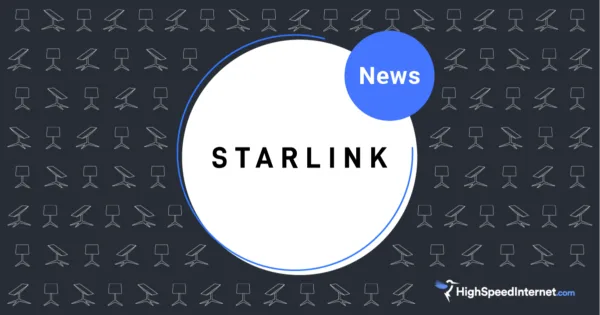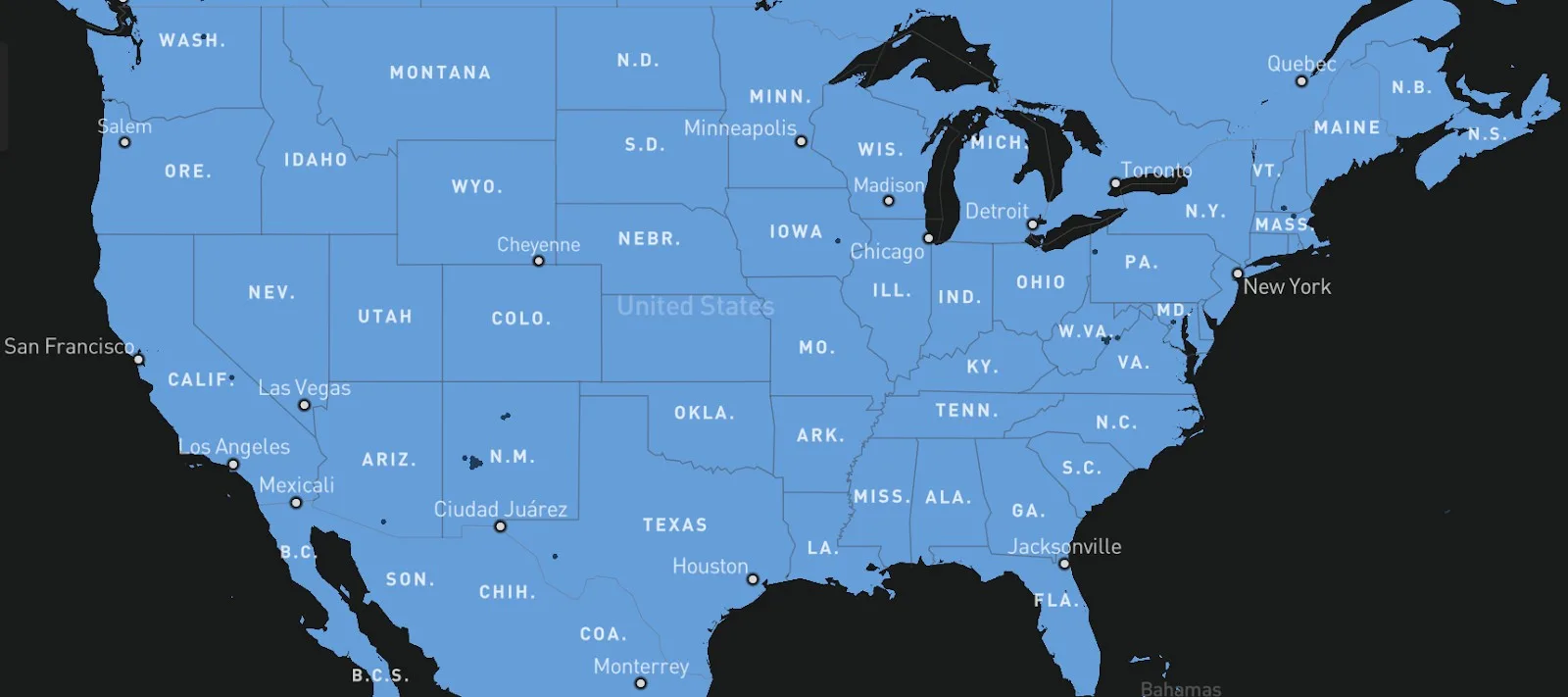When Will Starlink Be Available in My Area?
Starlink’s availability has skyrocketed since its launch
Dec 1, 2025 | Share
Brand Guides
 After years of constantly struggling to keep up with demand, Starlink has built an impressive global availability. Starlink now offers its satellite internet services in every state across the U.S. and in over 140 countries and territories worldwide. The chances of Starlink being available in your area are very high—though not yet 100% guaranteed.
After years of constantly struggling to keep up with demand, Starlink has built an impressive global availability. Starlink now offers its satellite internet services in every state across the U.S. and in over 140 countries and territories worldwide. The chances of Starlink being available in your area are very high—though not yet 100% guaranteed.
Starlink’s satellite constellation has grown to blanket the entire globe, and its service is available to 99.7% U.S. households, according to the FCC. Starlink has recently managed to get rid of its inconvenient waitlist—all while improving overall setup time. It has come a long way since it first launched and has made many strides to improve satellite internet service and revolutionize an industry that was often pushed aside.
Starlink is constantly changing its plan lineup, prices, and equipment costs—which makes it hard to pinpoint what it will cost you. If you’re thinking about signing up for Starlink, we’ll go over what you need to know about Starlink’s current availability and logistics.
On this page:
Is Starlink available in my area? | How does satellite availability work? | Starlink equipment | Other rural internet providers | The bottom line
On this page:
Is Starlink available in my area?
The short answer is: probably! Starlink is now available in most areas. To find out if Starlink is available in your area, the most direct way is to simply go to the Starlink website and enter your address. When you click on the Order Now button, you should get one of the following messages:
- Starlink is currently available in your area. You will be redirected to the checkout page.
- Starlink Residential is not available in your area. Enter your email below to be notified about future availability and product updates.
If Starlink is available at your address, you can then sign up for the service and order your equipment. You must purchase all your equipment up front, which is a big investment, but your wait should be on the shorter side—you’ll get an estimated shipping timeline for your order at checkout.
Starlink recently got rid of its waitlist, so you don’t need to pay a deposit to get put on a waitlist. Instead, you simply provide your email, and you’ll be notified of availability updates. Starlink has vastly expanded its service availability in the last few years, but if you live in an area where it’s not yet available, your best bet is to sign up for updates.
If you don’t want to wait, you could also sign up for Starlink Roam, though there are some significant differences between Roam plans and standard residential plans.
Still waiting on the Starlink expansion?
Check out the internet options available in your area now!
Starlink availability map
If you want to pinpoint Starlink coverage, the provider also has an interactive map.

Availability map courtesy of Starlink.
As of June, 2025, Starlink is available throughout most of the United States. There are still a few “coming soon” areas on the availability map that include small parts of New Mexico and West Virginia, plus a few very small areas in Washington, California, Iowa, Pennsylvania, and Maryland.
Starlink plans and pricing
| Package | Price | Speed |
|---|---|---|
| Starlink Residential 100 Mbps | $40/mo.* | Up to 100Mbps |
| Starlink Residential Lite | $80/mo.* | Up to 250Mbps |
| Starlink Residential | $120/mo.* | Up to 400Mbps |
| Starlink Roam 50GB | $50/mo.† | Up to 300Mbps |
| Starlink Roam Unlimited | $165/mo.* | Up to 300Mbps |
Data as of 12/01/2025.
*Plus hardware, shipping and handling fees, and tax. Fully refundable. Depending on location, some orders may take 2 weeks or more to fulfill.
†Users on Mini Roam are limited to 50GB of Mobile Data and can use in-motion beyond 100mph
Starlink offers two residential plans starting at $80 with speeds of up to 150Mbps. You can currently get a 30-day trial and your money back if you aren’t satisfied with your Starlink service. The Residential Lite plan is a good pick for those with smaller households or less internet usage since it’s deprioritized during peak hours. Starlink Roam, the portable internet service, is a great choice for travelers or those looking for a reliable internet service on the go. The trade-off is that it comes with higher prices and lower speeds, which may not be worth the sacrifice—it depends on your internet needs.
How does satellite availability work?
If you’ve been following the development of Starlink and other low-Earth orbit (LEO) satellite constellations, you’ve seen Starlink’s coverage gaps close since launch. When Starlink first launched, it struggled to simply offer availability across the U.S., but it now boasts nationwide coverage and an impressive global availability that’s unmatched by its competitors.
Starlink offers satellite internet service in more than 140 countries and territories across the globe. That’s incredible given that just a few years ago Starlink was wrangling with simply getting permission to operate in many countries.
Network capacity has been an ongoing issue since Starlink came out of its closed beta. The satellite network quickly became overloaded as more and more people used the service, which prompted Starlink to look for alternative ways to mitigate demand. It has imposed varying demand surcharges in areas with high-capacity areas. Though, these congestion charges vary depending on location and can change at any moment.
Geostationary (GSO) satellite internet providers like Viasat and Hughesnet have to deal with similar issues, though launching new satellites is a much more complicated task for them. Starlink has managed to surpass its competitors and bring monumental transformations to the satellite internet industry—all within a relatively short time compared to how long other satellite internet providers have been around.
Another problem unique to LEO satellites is the limited range of satellite teleport, or the ground-based side of satellite networks that connect a satellite to the rest of the internet. A GSO satellite can easily see a quarter of the Earth’s surface, so ISPs can build huge ground stations right on internet backbones and always maintain line of sight between the satellite and the ground station.
LEO satellites are close to Earth’s surface, so they can maintain line of sight only with stations within about 400 miles. That means providers need many more stations to keep internet service, and they have more limitations on where they can build them. Keeping all these limitations in mind, the progress Starlink has made since launch is no small feat.
No more Starlink equipment delays
Luckily, there have been major improvements with Starlink’s shipping time. Customers don’t have to struggle to receive their equipment and get their Starlink service started. Currently, Starlink provides an estimated shipping timeframe and the following order updates.
- Pending: Provides an estimated delivery date.
- Preparing shipment: Starlink is preparing to ship your order and provides an estimated delivery date.
- Shipped: Starlink will provide your tracking number so you can get the exact delivery date from the shipping carrier.
If you’re testing out Starlink with a 30-day trial and your Starlink Kit has been in transit for 30 days, Starlink will extend your trial period by applying a one-month service credit to your account.
Other rural internet options
Even if you’re a die-hard Starlink fan, most of us can’t go without internet for six (or more) months. If you’ve been waiting for Starlink to be available in your area, it’s a good idea to have a backup plan for the meantime, even if you do ultimately switch to Starlink once it’s available. If 5G home internet is available in your area, you might be able to get faster speeds for a lower price.
Top rural internet providers
| Plan | Starting price | Speed | Connection |
|---|---|---|---|
| Starlink | $120/mo.* | Up to 400Mbps | LEO Satellite |
| T-Mobile 5G Home Internet | $50/mo.† | Up to 498Mbps | 5G Home |
| Viasat | $119.99/mo.‡ | Up to 150Mbps | GSO Satellite |
| HughesNet | $39.99/mo.§ for first 12 mos. | Up to 100Mbps (stated speeds are not guaranteed) | GSO Satellite |
Data as of 12/01/2025. Offers and availability may vary by location and are subject to change. See disclaimers.
If you plan on using a temporary internet solution, make sure to look over the length of your contract. Satellite and fixed wireless providers might require contracts and charge hefty termination fees if you want to get out early. T-Mobile is a notable exception, making it a good stopgap (or long-term alternative) if it’s available in your area.
Keep an eye out for changes, congestion fees, and promotions
Starlink is constantly making changes—so it can be complicated to pinpoint exactly what it’s going to cost you. We can help break down recent changes and equipment costs to help you figure out how much Starlink costs in your area.
Keep an eye on Starlink’s everyday deals!
- Get Starlink Internet with no upfront Residential hardware cost and free professional installation in select areas
- Get a Starlink Residential Lite plan for $80 per month
- Get a 30-day trial of Starlink internet and if you don't like it, you'll get a full refund
The bottom line: No more waiting—for most!
If you’re an aspiring Starlink customer, you can most likely place your equipment order and get connected relatively quickly. No more waiting for months or being put on a waitlist. Starlink has made a big effort to streamline and speed up the process to get and set up Starlink satellite service. If you’ve been waiting to get Starlink, now’s your chance!
Want to see all your internet options?
Enter your zipcode to see what’s available in your area!
Disclaimers
* Starlink
- Plus hardware, shipping & handling fees, and tax. Fully refundable. Depending on location, some orders may take 2 weeks or more to fulfill.
- Users on Mini Roam are limited to 50GB of Mobile Data and can use in-motion beyond 100mph
† T-Mobile 5G Home Internet
- with AutoPay, taxes and fees included.
‡ Hughesnet
- Minimum term required and early service termination fees apply. Monthly Fee reflects the applied $5 savings for ACH enrollment. Offer may vary by geographic area.
§ Viasat
- Prices, speeds and availability vary by location. Prices are subject to change. No annual contract or installation fees are required. Monthly equipment lease fees and taxes may apply.
Author - Andrea GutierrezPrieto
After graduating from the University of Utah with an honors degree in Linguistics, Andrea Gutierrez Prieto transitioned from being an Analytic Linguist and Research Assistant to the HighSpeedInternet.com team. Andrea has a background in academic and research writing with a passion for helping readers make informed decisions. Off the clock, Andrea spends her time watching anime, reading manga, and baking delicious pastries at home.
Editor - Jessica Brooksby
Jessica loves bringing her passion for the written word and her love of tech into one space at HighSpeedInternet.com. She works with the team’s writers to revise strong, user-focused content so every reader can find the tech that works for them. Jessica has a bachelor’s degree in English from Utah Valley University and seven years of creative and editorial experience. Outside of work, she spends her time gaming, reading, painting, and buying an excessive amount of Legend of Zelda merchandise.




